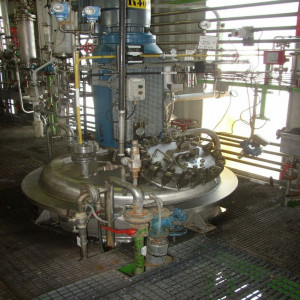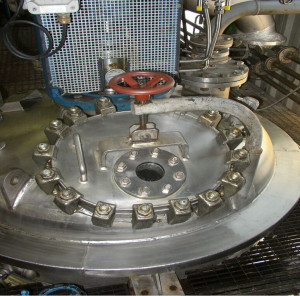A detonation occurred at 6:45 pm in a reactor on a pharmaceutical site. A worker sustained burns to the face. The device was placed under permanent inerting with nitrogen (N2). The most recent reaction held, a hydrogenation step, had been completed 2 days prior. During the ensuing hours, the reactor was washed 5 times with water in order to eliminate the catalyst and then twice with hot methanol to remove residual organic substances. The device was then vacuum-dried for several hours at 80°C, as the vacuum pump flushed vaporised methanol. Upon completion of this phase, pressure was restored under N2, the tank vent was opened, and a steady sweeping rate of 1,500 litres of N2 per hour was maintained to avoid air intake either through this vent or after opening the manhole to visually inspect the reactor. On the day of the accident, the device was examined twice (at 10 am and 5 pm), and another washing with water was requested to remove traces of deposit accumulation on its bottom. According to the operator, the technician had undoubtedly opened the manhole to rinse the reactor with a sprinkling pipe when the explosion occurred. The operator also remarked that: the technician had not filled in the operating sheet as required; the state of cleaning was insufficient; traces of palladium catalyst were present; and a pyrophoric hydrogenation catalyst in dry form was visible on the manhole. Moreover, the drying procedure was apparently not being respected, and the accompanying solvent evaporation could generate an explosive atmosphere. It also seemed that the inerting step had been inappropriately executed. Instead of restoring reaction pressure under N2 and opening the vent, to save time the technician used the bottom valve or the loading valve, causing an air intake, in which case simple sweeping with N2 proved inadequate to inert the entire reactor. Lastly, the N2 cooling procedure was tested: a return to atmospheric pressure under N2 did effectively inert the reactor, yet sweeping only partially fulfilled its role (since O2 content had risen from 2.2% to over 10% in 10 min). Air could thus penetrate into the reactor via the manhole during inspection. The structural integrity of the reactor was verified, valves controlled, the procedure for completing operating sheets recalled for all technicians (who once again were made aware of inherent risks, e.g. role of inerting, pyrophoric substances), a special joint washing instruction drafted, and the N2 sweeping rate raised to 5,000 litres/hour.
Download the detailed report in .pdf format (107 Kb)






